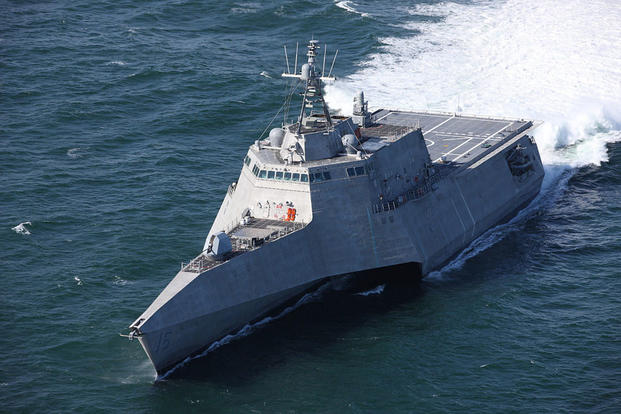The Pentagon's watchdog agency criticized the Navy's management of a new mine detection system for its littoral combat ships, prompting a response from top naval leaders who defended the service's actions.
Navy officials declared three of seven parts of its new mine countermeasures mission package had reached initial operating capability by summer 2017. That meant sailors were considered equipped and trained to conduct mission operations with three devices: the AN/ASQ‑235 Airborne Mine Neutralization System, the Airborne Laser Mine Detection System, and the Coastal Battlefield Reconnaissance and Analysis Block I system.
When the Defense Department inspector general reviewed the three platforms, investigators found signs they weren't meeting requirements, according to a report issued last week.
"We determined that the Navy declared IOC for the three [systems] ... prior to demonstrating that [they] were effective and suitable for their intended operational uses," the report states.
The three systems under IG review included:
- The AN/ASQ‑235 Airborne Mine Neutralization System, or AMNS, reached initial operational capability in November 2016. It deploys expendable destructors from MH-60S helicopters. Those vehicles are controlled from a console while they ID mines. Once they do, warheads are detonated to destroy the mines.
- The Airborne Laser Mine Detection System, or ALMDS, which also works with MH-60S helicopters, detects near-surface mine threats using laser imaging. Like the AMNS, the ALMDS reached initial operational capability in November 2016.
- The Coastal Battlefield Reconnaissance and Analysis system, known as COBRA, detects minefields and other obstacles in surf and beach zones ahead of an amphibious assault. It can be integrated with the Navy's MQ-8 Fire Scout, an unmanned helicopter that can operate from ships. COBRA reached initial operational capability in July 2017.
There were known performance problems with both the AMNS and ALMDS, the report states. Officials approved a plan to pursue initial operational capability to gather data and lessons learned. But the results of previous tests were used to justify it being rated mission capable before those performance problems were corrected, according to the report.
Similarly, the director of the Expeditionary Warfare Division declared COBRA had reached initial operational capability to "avoid requesting a sixth change ... that would further delay the delivery of the system capabilities to the fleet," the report states.
Because the mine countermeasures mission package relies on seven systems, each must "provide full capability and operate in conjunction with each other" to accomplish the mission, the inspector general found. If the Navy proceeds, sailors aboard the LCS and other platforms might receive gear that "cannot fully perform their mine detection and neutralization missions," according to the report.
"This in turn could lead to degraded mission performance, delayed delivery of needed capabilities, and the need to pull those units off-line and spend additional money to correct shortcomings in the fielded units," the report states.
The IG recommended that the Navy delay future procurement of the three systems until complete operational tests and evaluations demonstrate the systems are effective and suitable to support full-rate production.
There were memos stating the ALMDS and AMNS had not yet executed the complete initial operational tests and evaluations, according to the report. The Navy also had not yet demonstrated that the COBRA Block I system was able to conduct its full portfolio of mission operations.
"We disagree that the systems met the requirements for declaring IOC," the inspector general's office wrote.
But Navy leaders hit back, challenging those findings.
The assistant Navy secretary told the IG that all three systems "had met the requirements for the declaration of IOC as defined in their acquisition documentation."
The ALMDS and AMNS had "completed and exceeded expectations" for testing required by the LCS mine countermeasures mission package, and the COBRA successfully completed its first round of initial operational tests and evaluations to meet the requirements for IOC, the assistant secretary told the IG.
Inspectors then met with top Navy leaders to get an update on the three systems' development. The officials argued that having training squadrons use the systems is the best way to identify and correct performance gaps. The squadrons working with ALMDS and AMNS have not reported any problems, Navy officials said, according to the report. And shortcomings with the COBRA have been corrected.
The inspector general's office still cautioned the Navy in its approach.
"Entering full-rate production without demonstrating a system can perform as required may require costly retrofits to fix undiscovered system deficiencies," the report states. "In addition, the approach could also result in having to delay the planned decommissioning of legacy ships, helicopters, and associated equipment if deficiencies also render the new system unable to perform the full [mine countermeasures] mission set."
The Navy must continually improve the ALMDS, AMNS, and COBRA Block I systems based on feedback from the fleet. The IG's office also requested that service leaders provide documentation that the Navy has corrected any performance deficiencies for the three systems and demonstrate progress toward achieving its full portfolio of mission operations, while mitigating the risk of costly retrofits.
-- Gina Harkins can be reached at gina.harkins@military.com. Follow her on Twitter at @ginaaharkins.









